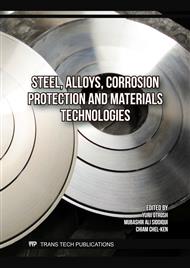[1]
S. Pourhashem, M.R. Vaezi, A. Rashidi, M.R. Bagherzadeh, Exploring corrosion protection properties of solvent-based epoxy-graphene oxide nanocomposite coatings on mild steel, Corros. Sci. 115 (2017) 78–92.
DOI: 10.1016/j.corsci.2016.11.008
Google Scholar
[2]
Q. Xiang, F. Xiao, Applications of epoxy materials in pavement engineering, Constr. Build. Mater. 235 (2020) 117529.
Google Scholar
[3]
J.R.M. D'Almeida, S.N. Monteiro, The effect of the resin/hardener ratio on the compressive behavior of an epoxy system, Polym. Test. 15(4) (1996) 329–339.
DOI: 10.1016/0142-9418(95)00037-2
Google Scholar
[4]
J. Chen, N. Chu, M. Zhao, F.L. Jin, S.J. Park, Synthesis and application of thermal latent initiators of epoxy resins: A review, J. Appl. Polym. Sci. 137(48) (2020) 49592.
DOI: 10.1002/app.49592
Google Scholar
[5]
A.S. Mora, R. Tayouo, B. Boutevin, G. David, S. Caillol, A perspective approach on the amine reactivity and the hydrogen bonds effect on epoxy-amine systems, Eur. Polym. J. 123 (2020) 109460.
DOI: 10.1016/j.eurpolymj.2019.109460
Google Scholar
[6]
E. Kalinina, E. Pikalova, Opportunities, challenges and prospects for electrodeposition of thin-film functional layers in solid oxide fuel cell technology, Mater. 14(19) (2021) 1–39
DOI: 10.3390/ma14195584
Google Scholar
[7]
Chemibond, Auto-Fix 8800-A & B: Product Information. 2024.
Google Scholar
[8]
J. Bosso, L. Burrell, M. Wismer, U.S. Patent 3,839,252 (1974).
Google Scholar
[9]
M. Wismer, J.F. Bosso, U.S. Patent 4,419,467 (1983).
Google Scholar
[10]
K.-T. Lau, J. Narayanasamy, C.C. Sorrell, Electrophoretic deposition as coating method for thermal conductive hexagonal boron nitride particles, in: Z. Mustafa, N.S. Khashi'ie (Eds.), Progress on Advanced & Smart Materials in Engineering and Mathematics, Vol. 3, Penerbit UTeM Press, Durian Tunggal, 2025, pp.65-82.
Google Scholar
[11]
R.E. Koh, C.C. Sun, Y.L. Yap, P.L. Cheang, A.H. You, Investigation of lithium transference number in PMMA composite polymer electrolytes using Monte Carlo (MC) simulation and recurrence relation, J. Electrochem. Sci. Technol. 12(2) (2021) 217–224.
DOI: 10.33961/jecst.2020.01459
Google Scholar
[12]
J.H. Joshi, D.K. Kanchan, M.J. Joshi, H.O. Jethva, K.D. Parikh, Dielectric relaxation, complex impedance and modulus spectroscopic studies of mix phase rod like cobalt sulfide nanoparticles, Mater. Res. Bull. 93 (2017) 63–73.
DOI: 10.1016/j.materresbull.2017.04.013
Google Scholar
[13]
R.O. Allen, P. Sanderson, Characterization of epoxy glues with FTIR, Appl. Spectrosc. Rev. 24(3–4) (1988) 175–187.
DOI: 10.1080/05704928808060457
Google Scholar
[14]
R.B. Leggat, S.A. Taylor, S.R. Taylor, Adhesion of epoxy to hydrotalcite conversion coatings: II. Surface modification with ionic surfactants, Colloids Surf. A Physicochem. Eng. Asp. 210(1) (2002) 83–94.
DOI: 10.1016/s0927-7757(02)00210-8
Google Scholar
[15]
A.B.D. Nandiyanto, R. Ragadhita, M. Fiandini, Interpretation of Fourier transform infrared spectra (FTIR): A practical approach in the polymer/plastic thermal decomposition, Indones. J. Sci. Technol. 8(1) (2023) 113–126.
DOI: 10.17509/ijost.v8i1.53297
Google Scholar
[16]
S. Morsch, Y. Liu, S.B. Lyon, S.R. Gibbon, B. Gabriele, M. Malanin, K.-J. Eichhorn, Examining the early stages of thermal oxidative degradation in epoxy-amine resins, Polym. Degrad. Stab. 176 (2020) 109147.
DOI: 10.1016/j.polymdegradstab.2020.109147
Google Scholar
[17]
J. Li, S. Tang, M. Lyu, H. Zhu, Y. Luo, C. Zhang, A dual cross-linking strategy enables fully bio-based epoxy thermosets with superior low dielectric properties and mechanical properties, Ind. Crops Prod. 220 (2024) 119117.
DOI: 10.1016/j.indcrop.2024.119117
Google Scholar
[18]
J.R. Lee, F.L. Jin, S.J. Park, J.M. Park, Study of new fluorine-containing epoxy resin for low dielectric constant, Surf. Coat. Technol. 180–181 (2004) 650–654.
DOI: 10.1016/j.surfcoat.2003.10.111
Google Scholar
[19]
M.S. McMaster, T.E. Yilmaz, A. Patel, A. Maiorana, I. Manas-Zloczower, R. Gross, K.D. Singer, Dielectric properties of bio-based diphenolate ester epoxies, ACS Appl. Mater. Interfaces 10(16) (2018) 13924–13930.
DOI: 10.1021/acsami.7b19085
Google Scholar
[20]
K.T. Lau, S. Samsudin, Electrophoretic deposition of hexagonal boron nitride particles from low conductivity suspension, Pertanika J. Sci. Technol. 30(2) (2022) 1237–1256.
DOI: 10.47836/pjst.30.2.21
Google Scholar


